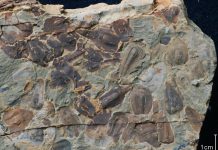
New research from Idaho State University is shedding light on Idaho’s State Dinosaur, Oryctodromeus.
This ancient creature, about the size of a large dog, lived during the Cretaceous Period and had some surprising features.
One of the most interesting discoveries is that two-thirds of its length was just its tail!
The research was led by L.J. Krumenacker, a geosciences professor at Idaho State University and a curator at the Idaho Museum of Natural History.
He and his team analyzed hundreds of bones from over a dozen Oryctodromeus specimens. Their findings were published in the Journal of Vertebrate Paleontology.
“Science is exciting because every new answer often brings new questions,” said Krumenacker. “We found that Oryctodromeus had an unusually long tail for a burrowing dinosaur. This raises questions about why it needed such a long tail.”
The team also discovered ossified tendons in the fossils. These tendons, which had turned into bone, were found along the dinosaur’s tail, neck, and back.
“These tendons would have made the spine very rigid and supported the long tail,” Krumenacker explained.
“But it makes us wonder how the dinosaur turned around in its burrows. Maybe the burrows had multiple entrances and exits, or perhaps Oryctodromeus lived in colonies like groundhogs do today.”
The new bones found in the mountains east of Idaho Falls, Idaho, and south of Lima, Montana, make Oryctodromeus one of the most complete specimens of its group.
Orodromines, the group of burrowing dinosaurs to which Oryctodromeus belongs, lived mainly in what is now the United States and Canada, but some have also been found in South Korea.
“Orodromines are special because they were the first dinosaurs recognized as burrowers,” Krumenacker said. “This discovery has helped scientists understand that burrowing might have been a common behavior in small dinosaurs.”
At the Idaho Museum of Natural History, the Oryctodromeus fossils are being digitally scanned as part of a project to create 3D models of all dinosaur-age fossils in their collection. These scans will be available on Morphosource, a public online database where anyone can view and download 3D models of important natural history objects.
“The fossils we’ve scanned include dinosaur eggs, teeth, and bones,” said Robert Gay, the museum’s education coordinator. “So far, we’ve scanned over 450 bones, and 30% of them belong to Oryctodromeus.”
The museum will also create a new mounted skeleton of Oryctodromeus based on the latest research. Additionally, they are developing educational kits to help teach people about Idaho’s State Dinosaur. These kits will be available in select locations throughout Idaho.
“Conserving and educating people about our state dinosaur is important because it is part of Idaho’s natural heritage,” Gay said. “Learning about these dinosaurs and their environment can help us understand our past better. Engaging with natural history can inspire better care for our planet.”
Krumenacker added, “Appreciating any part of the natural world, whether it’s dinosaurs or modern animals and plants, leads to better stewardship of our unique planet.”



